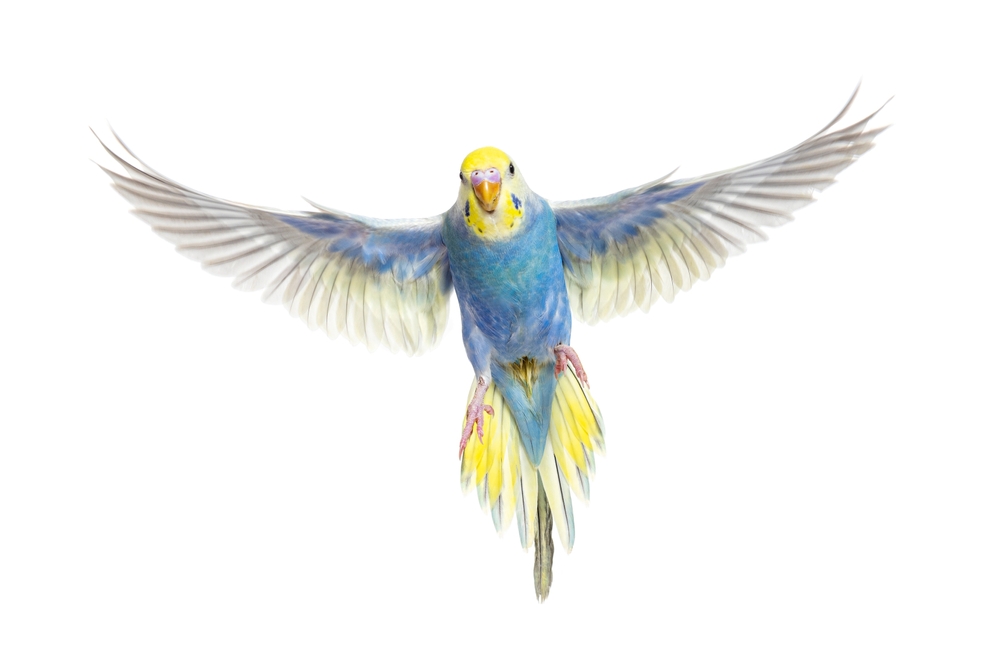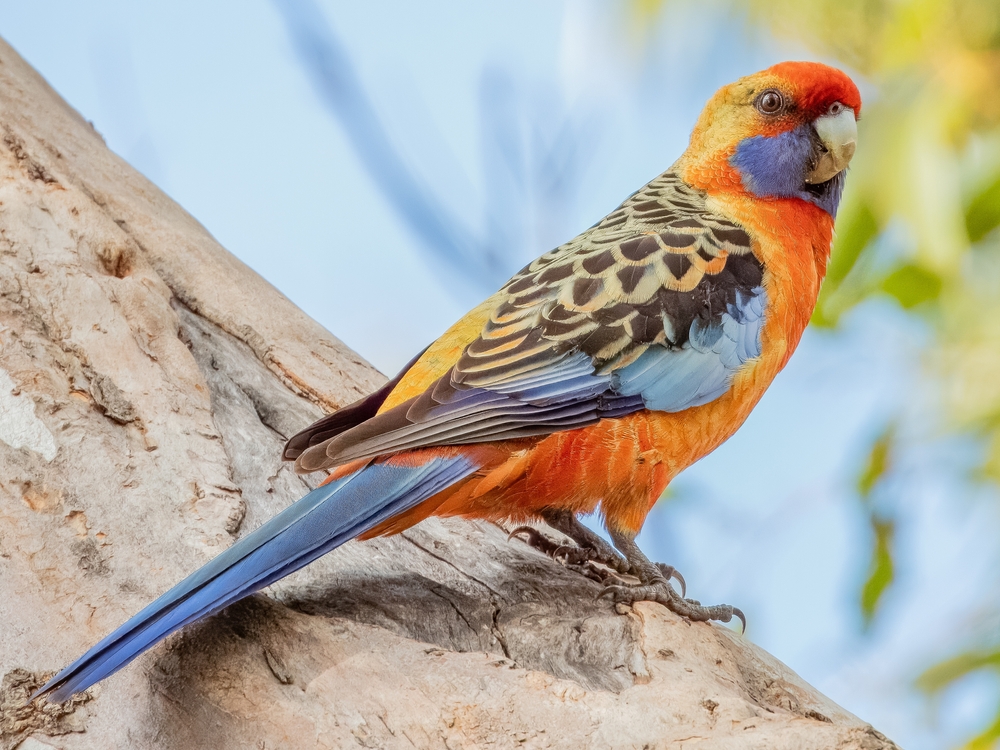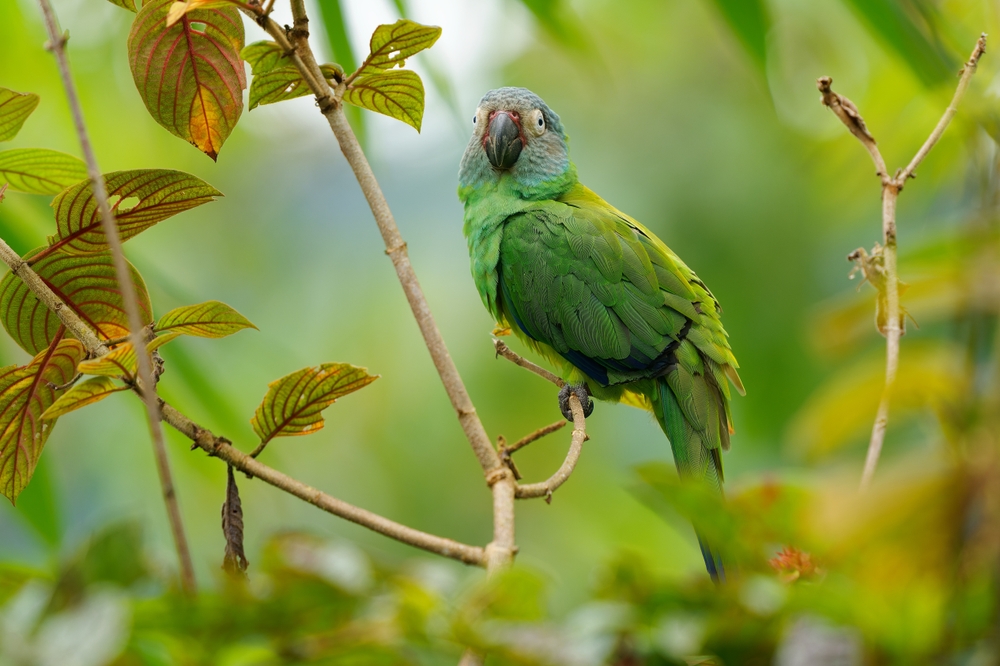The Budgerigar is unique as the only living species in its genus (Melopsittacus). Its closest relatives are the fig parrots (Cyclopsitta) and the ground parrot (Pezoporus), which share evolutionary ties within the parrot family.
About
The Budgerigar Parakeet (Melopsittacus undulatus), often simply called the budgie, is a small but iconic parrot of the Psittaculidae family. Native to the open woodlands and grasslands of Australia, it is one of the most widely recognized parrot species in the world. Renowned for its playful personality, intelligence, and ability to mimic human speech, the budgerigar has become the most popular pet parakeet globally.
In the wild, budgerigars are nomadic, moving in large flocks in response to rainfall and food availability. They measure about 18 centimeters (7 inches) in length and weigh between 30 and 40 grams (1 to 1.4 ounces). Their natural plumage is bright green with black scalloping across the wings and back, and a yellow face. Domesticated budgies, however, have been selectively bred into a wide array of colors, including blue, white, yellow, and grey, while retaining their cheerful energy.
Budgerigars feed primarily on grass seeds and grains, often foraging in groups that provide safety from predators. In captivity, they thrive on a diet of seeds, fruits, and vegetables. Their playful, social behavior and vocalizations make them engaging companions, while their relatively small size and ease of care contribute to their popularity.
Breeding in the wild occurs after rainfall, when food is abundant. Budgies nest in tree hollows or cavities, where females lay four to six eggs. Both parents contribute to raising the chicks, which fledge after about a month. Their high reproductive rate, combined with adaptability to arid conditions, ensures their survival in the unpredictable Australian climate.
Although abundant in the wild and not threatened, budgerigars hold deep cultural and economic importance as both native wildlife and beloved pets. Their charm, adaptability, and lively spirit have made them ambassadors of the parrot world.
Physical Characteristics
The Budgerigar, also known as the common parakeet or budgie, is a small, slender parrot native to Australia, celebrated for its bright colors and lively personality.
Plumage: In the wild, budgerigars are mostly green and yellow, with black scalloped markings on the wings, back, and head. Domestic varieties, however, come in a wide range of colors including blue, white, gray, and violet. The throat is marked with a series of small black spots, and the long tail feathers are typically blue to dark green.
Head & Beak: The head is rounded with small black eyes and a short, hooked beak adapted for cracking seeds. Above the beak is a fleshy cere (nostril area) that differs by sex—blue in males, brown or beige in females during breeding condition.
Body & Wings: The body is slim and streamlined, designed for agile, rapid flight across open grasslands. Wings are pointed and narrow, providing speed and maneuverability, while the tail is long and tapering.
Size:
-
Length (Body and Tail): 6.5–7.5 in (16–19 cm)
-
Wingspan: 10–12 in (25–30 cm)
-
Tail Length: 3–4 in (8–10 cm)
Weight:
-
Adult Male: 1.1–1.3 oz (30–35 g)
-
Adult Female: 1.0–1.2 oz (28–32 g)
The Budgerigar’s small size, long tapering tail, and characteristic green-and-yellow plumage in the wild make it instantly recognizable, while its domestic color varieties have made it one of the most popular pet birds worldwide.
Reproduction
The Budgerigar has a highly adaptable and prolific reproductive cycle, suited to the unpredictable climates of Australia’s grasslands.
1. Mating and Courtship:
Budgerigars are monogamous during the breeding season. Courtship includes singing, head-bobbing, and feeding displays by the male, who offers food to the female as a bonding ritual.
2. Breeding Season:
Unlike many parrots, Budgerigars breed opportunistically after rains, when grass seeds are abundant. This means they can nest at almost any time of year if conditions are favorable.
3. Nesting:
They nest in tree hollows, fence posts, or crevices, where the female prepares a simple depression in the wood dust or debris inside. They are colonial breeders, with multiple pairs nesting in the same area.
4. Egg Laying and Incubation:
The female lays 4–8 eggs, though clutches of 5–6 are most common. Eggs are white and rounded. Incubation lasts about 18–21 days, performed entirely by the female, while the male feeds her.
5. Hatching and Chick Development:
Chicks hatch blind, naked, and helpless. They are fed by regurgitation, receiving a mix of seeds and plant matter softened by the parents. Down feathers appear after the first week, and eyes open around 10 days.
6. Fledging:
The young fledge at about 4–5 weeks, but remain dependent on their parents for 1–2 additional weeks as they learn to forage.
7. Sexual Maturity:
Budgerigars reach maturity quickly, often breeding as early as 6 months, though most breed around 1 year of age.
The Budgerigar’s opportunistic breeding and ability to raise large clutches allow it to thrive in fluctuating environments, contributing to its status as one of the most abundant wild parrots in Australia.
Lifespan
The Budgerigar is a relatively short-lived parrot compared to larger parakeets and macaws, though it thrives both in the wild and in captivity under proper care.
Lifespan in the Wild:
In their natural Australian grassland and scrub habitats, Budgerigars typically live 5–8 years. High predation from raptors and reptiles, variable food availability, and harsh climatic conditions limit their longevity in the wild.
Lifespan in Captivity:
With good diet, enrichment, and veterinary care, Budgerigars can live up to 10–15 years, with some exceptional individuals reaching 18–20 years. Their small size makes them more delicate than larger parrots, but stable conditions greatly extend their lives.
Threats to the Budgerigar:
-
Predation: Falcons, hawks, snakes, and monitor lizards prey on both adults and chicks.
-
Climate Variability: Drought reduces seed crops, leading to poor breeding success and survival.
-
Disease: Captive birds are prone to respiratory infections, mites, and psittacosis if not well cared for.
-
Human Impact: Habitat modification and pesticide use can affect wild populations, though the species remains abundant.
Conservation Status:
The Budgerigar is listed as a species of Least Concern by the IUCN due to its vast population and adaptability. It remains the most numerous wild parrot species on Earth.
Eating Habits
The Budgerigar is a seed-eating specialist, perfectly adapted to the grassland habitats of inland Australia.
Diet:
Wild Budgerigars primarily feed on the seeds of native grasses such as spinifex, Mitchell grass, and saltbush. They also consume seeds of cultivated crops, berries, and occasionally fruits or greens. During breeding, they may supplement their diet with small insects and larvae for added protein.
Foraging Strategy:
They forage in large flocks, often moving across vast distances in search of fresh seeding grasses after rain. Budgerigars typically feed on the ground, but will also cling to grass stems to strip seeds directly.
Feeding Behavior:
Highly social, they eat in noisy flocks where constant chatter serves as both communication and a defense against predators. They drink water daily when available, sometimes flying long distances to reach waterholes.
Crop Feeding:
Their expandable crop allows them to store seeds temporarily, both for digestion and for regurgitating food to feed mates or chicks.
Feeding Young:
Parents feed their chicks by regurgitation, providing a soft mix of partially digested seeds. This ensures that chicks receive easily digestible nutrients during growth.
Seasonal Feeding:
Diet shifts with seed availability. After rains, fresh green grass seeds dominate, while in dry seasons, they rely on stored seeds in the environment or cultivated crops.
The Budgerigar’s efficient seed-based diet, flock foraging, and mobility across arid landscapes are key factors in its success as one of the most numerous parrot species in the world.
Uniqueness
The Budgerigar, or “budgie,” is one of the most distinctive and successful parrots in the world, with traits that set it apart from other parakeets:
Most Numerous Parrot: It is the most abundant wild parrot species on Earth, with millions forming massive flocks that can darken the skies over inland Australia.
Nomadic Lifestyle: Unlike many parrots with fixed ranges, budgerigars are highly nomadic, traveling great distances in search of food and water, following seasonal rainfall patterns.
Colorful Domestic Varieties: While wild budgerigars are always green and yellow, centuries of selective breeding have produced hundreds of domestic color mutations, including blue, violet, white, and pied varieties.
Small but Hardy: Despite their small size, budgerigars survive Australia’s harsh interior climate by their ability to travel long distances, conserve water, and breed opportunistically after rain.
Vocal Mimics: They are among the best mimics of human speech among parrots. Some individuals have been recorded with vocabularies of over 1,500 words.
Fast Reproduction: Their ability to breed quickly after rains, with large clutches and short nesting cycles, gives them an evolutionary advantage in unpredictable environments.
Cultural Icon: Budgies are one of the most popular pet birds worldwide, valued for their bright colors, cheerful nature, and ability to bond with humans.
The Budgerigar’s combination of abundance in the wild, adaptability, and extraordinary popularity in captivity makes it one of the most unique and remarkable parrots in existence.
Be the First to Share Photos of This Species.
FAQ’s
1. What is the closest species to the Budgerigar?
2. How does the Budgerigar compare to other parakeets?
It is much smaller than parakeets like the Alexandrine or Rose-ringed Parakeet, measuring only about 7 in (18 cm). Unlike larger parakeets, it is adapted to Australia’s dry grasslands, traveling nomadically in huge flocks rather than holding fixed forest territories.
3. What national parks provide the best opportunities to see a Budgerigar?
What national parks provide the best opportunities to see a Budgerigar?
-
Kakadu National Park, Australia – Flocks gather near wetlands and grassy plains.
-
Uluru–Kata Tjuta National Park, Australia – Large flocks often seen at waterholes.
-
Simpson Desert National Park, Australia – Nomadic flocks follow seeding grasses after rains.
-
Lake Eyre Basin reserves, Australia – Budgerigars congregate in massive numbers during wet seasons.
-
Sturt National Park, Australia – Regular sightings across arid grasslands.






































































